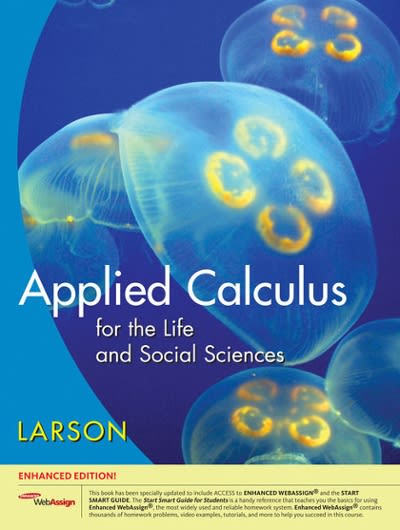Question
4.1 Medidas de dispersin (Valor: 53 puntos) Instrucciones: En esta tarea se trabajar con las medidas de dispersin. Calculars las medidas de dispersin para poblaciones
4.1 Medidas de dispersin (Valor: 53 puntos)
Instrucciones:
En esta tarea se trabajar con las medidas de dispersin. Calculars las medidas de dispersin
para poblaciones y muestras, tanto para datos sin agrupar como para datos agrupados. Debes presentar los
procesos necesarios para sustentar la respuesta de los ejercicios y redondear los resultados finales
no los valores intermedios que aparecen durante los clculos a dos lugares decimales,
cuando sea necesario.
Pregunta #1
1) Cul de las medidas de dispersin te gusta ms? Explica. (2 puntos)
Pregunta #2
1) Un nutricionista obtiene las cantidades de azcar (gramos) de 10 cereales diferentes,
incluyendo Cheerios, Corn Flakes, Froot Loops y otros siete. Las cantidades aparecen a
continuacin: 6, 24, 33, 47, 43, 7, 41, 23, 44, 39. Calcula la desviacin estndar de la
cantidad de azcar del cereal que consume la poblacin de todos los puertorriqueos que
comen cereal (Triola, 2004). (4 puntos)
Pregunta #3
1) El salario mensual de cinco (5) empleados de una farmacutica fue el siguiente: $3,667,
$4,935, $3,876, $4,700 y $3,178. Cul debera ser el valor de la desviacin estndar para
esos datos? (4 puntos)
Pregunta #4
1) Los tiempos de espera de ocho (8) pacientes para ser atendidos en una oficina mdica,
expresados en minutos fueron los siguientes: 34, 46, 42, 29, 31, 34, 51, 63. Calcula lo
siguiente: rango, varianza y desviacin estndar. (6 puntos)
Pregunta #5
1) Las edades de las 10 mejores actrices de Hollywood son las siguientes: 33, 48, 51, 35,
57, 67, 52, 44, 48, 70. Utiliza las 10 edades de las mejores actrices para calcular el
rango intercuartil. (6 puntos)
Pregunta #6
1) Utiliza los siguientes datos muestrales para calcular el coeficiente de variacin de cada
muestra; despus, compara los resultados. (6 puntos)
Peso de estudiantes de ambos sexos de NUC University: 159, 165, 197, 200, 165, 143,
154
Tamao en pulgadas de bebs al nacer: 12.2, 15.3, 11.4, 10, 15.8, 13.5, 14.1
Pregunta #7
2) La distribucin de frecuencia presentada describe la velocidad en que unos jvenes
conducan para llegar a tomar sus clases a la universidad. Estos jvenes conducan por
una carretera cuyo lmite de velocidad era de 35 mi/h. Calcula la varianza y desviacin
estndar. (6 puntos)
Velocidad Frecuencia
42-45 20
46-49 16
50-53 11
54-57 4
58-61 1
Pregunta #8
1) Se presentan los siguientes datos muestrales: 5.1, 3.1, 5.5, 5.1, 8.3, 13.7, 5.3, 4.9, 3.7, 3.8, 9.8. Calcula lo siguiente:
a) media (3 puntos)
b) moda (2 puntos)
c) mediana (2 puntos)
d) eje medio (4 puntos)
e) rango (2 puntos)
f) varianza (4 puntos)
g) desviacin estndar (2 puntos)
______________________________
4.1 Measures of dispersion (Value: 53 points)
Instructions:
In this task we will work with the dispersion measures. You will calculate the measures of dispersion
for populations and samples, both for ungrouped data and for pooled data. You must present the
processes necessary to support the answer of the exercises and round the final results
Not the intermediate values that appear during calculations to two decimal places, when necessary.
Question 1
1) Which of the dispersion measures do you like the most? Explain. (2 points)
Question # 2
1) A nutritionist obtains the amounts of sugar (grams) from 10 different cereals,
including Cheerios, Corn Flakes, Froot Loops, and seven others. The amounts appear at
continuation: 6, 24, 33, 47, 43, 7, 41, 23, 44, 39. Find the standard deviation of the
amount of cereal sugar consumed by the population of all Puerto Ricans who
they eat cereal (Triola, 2004). (4 points)
Question # 3
1) The monthly salary of five (5) employees of a pharmaceutical company was as follows: $ 3,667,
$ 4,935, $ 3,876, $ 4,700 and $ 3,178. What should be the value of the standard deviation for
These data? (4 points)
Question # 4
1) The waiting times of eight (8) patients to be seen in a medical office,
expressed in minutes were the following: 34, 46, 42, 29, 31, 34, 51, 63.
next: range, variance and standard deviation. (6 points)
Question # 5
1) The ages of the top 10 Hollywood actresses are as follows: 33, 48, 51, 35,
57, 67, 52, 44, 48, 70. Use the 10 ages of the best actresses to calculate the
Interquartile range. (6 points)
Question # 6
1) Use the following sample data to calculate the coefficient of variation for each
sample; then compare the results. (6 points)
Weight of students of both sexes at NUC University: 159, 165, 197, 200, 165, 143, 154
Size in inches of babies at birth: 12.2, 15.3, 11.4, 10, 15.8, 13.5, 14.1
Question # 7
2) The frequency distribution presented describes the speed at which some young people
they drove to get to take their classes at the university. These young men were driving by
a road whose speed limit was 35 mi / h. Calculate the variance and deviation
standard. (6 points)
Speed Frequency
42-45 20
46-49 16
50-53 11
54-57 4
58-61 1
Question # 8
1) The following sample data are presented: 5.1, 3.1, 5.5, 5.1, 8.3, 13.7, 5.3, 4.9, 3.7, 3.8, 9.8. Calculate the following:
a) mean (3 points)
b) mode (2 points)
c) median (2 points)
d) median axis (4 points)
e) rank (2 points)
f) variance (4 points)
g) standard deviation (2 points)
Step by Step Solution
There are 3 Steps involved in it
Step: 1

Get Instant Access to Expert-Tailored Solutions
See step-by-step solutions with expert insights and AI powered tools for academic success
Step: 2

Step: 3

Ace Your Homework with AI
Get the answers you need in no time with our AI-driven, step-by-step assistance
Get Started


